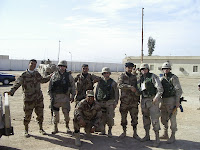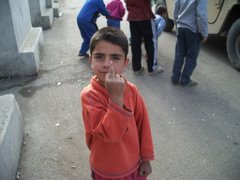
I recently saw an article about a long time Reserve Soldier. In the article the soldier pointed out the differences in the Reserve Component born of 20 years evolution from a strategic reserve to an operational reserve. I realized that many of my readers do not appreciate the distance traveled by the Reserve component over the last 25 years so I thought I’d give a little history primer of where we were and where we are in the Army Reserve.
Keep in mind that I offer this historical review based upon my experiences and impressions resulting from 24 Years as a Active and reserve soldier and 18 years as a fulltime military technician in the Army Reserve.
1980 was the year of my first visit to a Reserve unit Drill – while in ROTC I looked into the SMP program and visited a drill at a Field Artilley Battery. The drill was held at a small reserve center in Western Pennsylvania. There was no evidence of any artillery piece in the facility… the drill consisted of the review of regulations and preparation for an upcoming trip to Ft. Indiantown Gap for one of a few training sessions with equipment. The soldiers were all local and many were untrained in artillery or even combat Arms – they were simply hanging out and plugging along as resources to train and learn the skills were not available.
1982 – I entered active Duty for 4 years – only affillitaion with the Reserve Componenbt was with the 2 National Guard units. One was a enhanced separate Brigade in the Guard – they received more dollars, equipment and assistance than regular guard units – as a result they were better trained, had higher Duty MOSQ rates and were more ameiable to train hard when we visited them. The other unit was a regular National Guard Armor Battalion – I was tasked to evaluate a company at AT training. The unit was old school – coolers on the floors of the M48A5 tanks (at that point at least 20 years old and obsolete) commanders that did not know what an operations order was and largely motivated but unskilled soldiers. It was heartbreaking to see a unit with virtually no modern equipment play at being army – the will was there but the resources were not.
1986 – having left the active Army, I had the opportunity to join one of only two Army Reserve Armor Battalions in existence at the time. Having spent 4 years on active duty and needing some additional $s I walked into the Battalion headquarters and was a company commander within two months…. Shortly thereafter I started my life as a Military Technician with that unit.
This unit again had extremely dedicated soldiers that wanted to be tankers and combat arms. The majority of the unit was volunteers and many like myself had some active duty time under our belts. Here again the resources were extremely limited. Annual training was strictly limited to 14 days and weekends could not exceed 2 days on average. Despite tremendous amounts of G&C time there were considerable gaps in what could be accomplished annually in the way of training. For Combat Arms – training in maneuver and operating and completing a live fire gunnery qualification were forced to every other year. There was never enough time, dollars or ammunition allocated to do both tasks in the same year. This forced the organization to a “gunnery” year and a “maneuver” year. Slowly, however, the pace and attitudes changed. In the late eighties the active component was assigned to mentor the Army Reserve units. Affiliations were required and in our case we had the Army’s only airborne Armor Battailon as our mentor. Annual training was a jointly planned event with Active component soldiers mentoring, not grading – they took interest in our success and provided valuable training assistance.
In 1993 my assignment took me to an Mech Infantry Battalion and we participated in an NTC rotation – indicating the evolution in funding for annual training to provide more realistic events that was the result of Desert Storm. As the Active componet Army was pared down, increased emphasis was placed upon the Reserves and their capabilities.
1995 was a dark year – as I was part of a M1 Transition team condiucting new equipment training for my Armor Battalion we learned of the deal between the Army Reserve and National guard to divest the Army Reserve of Combat Arms. A blow felt directly to the mid-section of us combat arms soldiers that were now finally much better equipped and better trained. We were offered a modicum of assignments in the ensuing restructure to units of company size. (I actually saw infantrymen offered jobs as Quartermaster fabric repairmen). Many were displaced and the taste in our mouths as combat arms soldiers was bitter. Frankly the Army Reserve screwed up and lost many a talented soldier in that blunder.
1995-2001 was a period of adjustment, AC/RC program and other programs that strengthened the ties between active and Reserve component soldiers. It was also in this period that many active component soldiers joined the reserves as they departed the Active force further improving the training expectations and staffing for reserve units. This was probably the most productive growth years for the capabilities of the Reserve units. I was assigned to a unit that had a year round real training mission and shared tasks with active component organizations. The unit wasn’t equal perhaps, but certainly more respected and capable to complete its assigned missions. Training dollars, facility improvements, changes to installation support, issue of near modern equipment made the difference as Reserve soldiers felt much more a part of the total force in this period.
2001-present – this was the utilization phase for the Reserve Component. All of the sudden our soldiers were being assigned to active duty assignments, tours and mobilizations. In my case, I was deployed with a month’s time from alert to actual assignment in a combat theater on an active component unit’s staff. Was I prepared? Yes – I actually found that I was able to quickly assume the duties required. I had to learn some new tools of the trade that were not yet issued to the Reserve component (FBCB2, Squad Radios, etc…) but that did not take long to do. The basics of soldier tasks were easily updated and refreshed and I believe I provided a plausible performance in Iraq when I was called in 2004. The reason for the success was the push to a partnership with active component resources. Installations, trainers, assigned Active component soldiers, equipment were pushed to units and the mantra of Reserve soldiers as second class was largly forgotten.
What is the recipe in this dynamic relationship between Active and reserve components? I like to use an analogy to illustrate - Being in the Reserve Component is like being on a minor league baseball team. You practice and develop skills to play the same game played in the Major League. The rules are the same, same standards, same playing field. In the minors you won’t have the same dollars, your equipment may be a little older, some of the players may be a little past their prime, and you don’t play on TV or in front of the big crowds. But – you never know when you will be called up to play in the major league, in front of a bigger audience. In fact, your whole team may be called up together. Right at that moment, your skills have to be as sharp as possible, honed in a less glamorous locale under more austere conditions. You won’t get the luxury of more training, practice or mentoring – this is it – do the job now. That is life in the Reserve Component today.
We should endeavor to continue to make sure we resource the Reserve component soldier for success when he/she steps up to the big league playing field – we don’t have a lot of alternatives on the bench… make sure that soldier given the job has had ample opportunity to hone their skills to bring us the win on the global playing surface. And maybe we need to attend more of the minor league games, follow the roster a bit more and cheer the successes at that level – knowing that we need to appreciate and support the effort at that level that we have come to rely upon.





